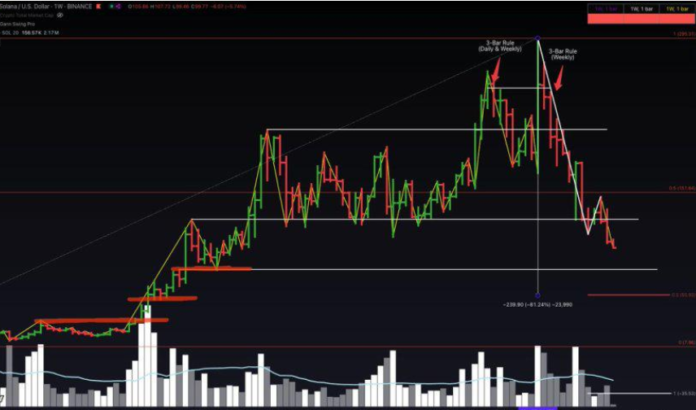Cryptocurrencies, particularly Solana (SOL), have captured the attention of investors, traders, and enthusiasts in recent years. As one of the leading blockchain platforms in the digital space, Solana has experienced significant price fluctuations, often baffling both new and seasoned investors. Understanding the factors that contribute to these price movements is crucial for anyone looking to engage in the Solana ecosystem. In this article, we will explore the reasons behind the fluctuations in Solana’s current price and examine various aspects that influence it.
Introduction to Solana: A Brief Overview
Solana is a high-performance blockchain designed to support decentralized applications (dApps) and crypto-currencies. It is known for its scalability, high throughput, and low transaction costs, making it an attractive choice for developers. However, despite its strong technical foundation, Solana has been subject to price volatility, like many other cryptocurrencies. To understand why the price of Solana fluctuates, it is necessary to explore the factors affecting its market value.
What Drives Cryptocurrency Price Movements?
Before delving into the specifics of Solana, it’s important to understand the general drivers of cryptocurrency prices. Several fundamental factors influence the price of digital currencies, including:
1. Market Demand and Supply
Like any other asset, cryptocurrency prices are significantly influenced by market demand and supply. If more people are buying Solana, the price increases. Conversely, if there is a surge in selling pressure, the price tends to fall. This basic economic principle governs much of the short-term volatility in the market.
2. Investor Sentiment
Cryptocurrencies are highly susceptible to investor sentiment. Positive news, high-profile endorsements, and strong community support can drive up the price of Solana. On the other hand, negative news such as security breaches or regulatory concerns can create panic, leading to sell-offs and sharp price declines.
3. Regulatory Environment
Governments across the world are continuously working on regulating the cryptocurrency market. Changes in regulations or new laws can have a major impact on solana current price. For instance, the approval of Bitcoin ETFs or stricter cryptocurrency laws could send Solana’s price either soaring or plummeting, depending on the regulatory stance.
4. Technological Developments
As a blockchain platform, Solana’s value is partly derived from its technological developments and upgrades. Any new features, partnerships, or improvements to Solana’s infrastructure could lead to increased demand and, as a result, a rise in price. Conversely, technical failures or delays in development can undermine investor confidence, leading to price declines.
Key Factors Affecting the Fluctuations in Solana’s Price
1. Solana’s Network Performance and Speed
One of Solana’s standout features is its ability to process transactions at incredibly high speeds. As the network grows and scales, more people use it to transact, and this can impact the price. A smooth, fast-performing network enhances investor confidence and can positively affect the price. However, network downtime or performance issues can lead to a loss of trust, negatively impacting price stability.
2. Market Liquidity
Liquidity refers to the ease with which Solana can be bought or sold on exchanges. Higher liquidity tends to stabilize prices, while lower liquidity often results in more volatile price movements. Solana’s liquidity can fluctuate based on trading volumes, the number of exchanges listing it, and the amount of SOL being traded in the market.
3. Institutional Investment
Institutional involvement in Solana can have a profound impact on its price. Large institutions entering the market can drive demand and push the price up significantly. Conversely, institutional withdrawals or bearish actions can cause a sharp decline in price.
4. Competition from Other Blockchain Projects
Solana is not the only blockchain in the market. Competitors like Ethereum, Cardano, and Polkadot offer similar functionalities, and their advancements can influence Solana’s price. For instance, if Ethereum releases a significant update or introduces a new feature that solves scalability issues, investors may shift their focus from Solana to Ethereum, causing price fluctuations.
Solana’s Price Trends: Short-Term vs. Long-Term
Understanding the fluctuations in Solana’s price requires distinguishing between short-term and long-term price movements.
Short-Term Price Movements
Short-term price fluctuations in Solana are typically driven by news, social media trends, or sudden shifts in market sentiment. These fluctuations can happen within hours or days. As a trader, capitalizing on short-term price changes can be profitable but requires a keen understanding of the market’s mood.
Long-Term Price Movements
Long-term price trends in Solana are typically driven by the fundamental growth of its ecosystem, technological advancements, and adoption rates. Over time, as more dApps are built on Solana and its user base grows, the demand for SOL tokens may increase, driving the price upwards. Investors with a long-term view are more likely to focus on these fundamental factors rather than daily market fluctuations.
The Role of News and Media in Solana’s Price Fluctuations
News plays a crucial role in shaping investor sentiment. A well-placed piece of positive news, such as a new partnership or upgrade to the network, can boost Solana’s price. Conversely, negative news, such as reports of hacks or network downtime, can lead to fear, uncertainty, and doubt (FUD), which can cause investors to sell off their holdings and lead to a decline in price.
Media and Social Media Impact
In the era of social media, the price of Solana can also be heavily influenced by influencers, celebrities, and high-profile individuals who discuss or promote the coin. A tweet from a notable figure can send Solana’s price soaring, while rumors or misleading statements can send it crashing.
Common Misconceptions About Solana Price Movements
1. Only Speculation Drives the Price
While speculation plays a role, many investors mistakenly believe that speculation is the only factor behind Solana’s price movements. In reality, factors like technological advancements, real-world adoption, and network upgrades play just as significant a role.
2. Price Will Always Go Up
Many newcomers to the crypto space believe that the price of Solana will continue to rise indefinitely. However, like any other market, cryptocurrencies are cyclical, and Solana is not immune to market corrections, crashes, or periods of stagnation.
Strategies to Navigate Solana’s Price Fluctuations
1. Stay Informed
Staying updated on the latest news and trends in the cryptocurrency market is crucial. This includes following Solana-related developments and being aware of any changes in the broader crypto market that could affect Solana’s price.
2. Set Realistic Expectations
Understanding the potential for both ups and downs in Solana’s price is essential. Setting realistic expectations helps prevent emotional reactions during periods of high volatility. Investors should plan based on long-term goals rather than trying to time the market for short-term gains.
3. Diversify Your Portfolio
Rather than putting all your eggs in one basket, diversifying your portfolio can reduce risk and exposure to price fluctuations in Solana. A diversified portfolio allows you to weather downturns in one asset while benefiting from growth in others.
Frequently Asked Questions (FAQs)
1. Why does Solana’s price fluctuate so much?
Solana’s price fluctuates due to factors like market demand, investor sentiment, technological developments, competition, and regulatory news. Cryptocurrencies are highly volatile, and all these factors contribute to its price movements.
2. Is Solana a good investment in 2025?
Solana’s future as an investment will depend on several factors, including network upgrades, market conditions, and competition. It’s important to conduct thorough research and consider long-term trends before investing.
3. What are the risks of investing in Solana?
The risks include market volatility, security issues, competition from other blockchain platforms, and regulatory concerns. Cryptocurrencies can be unpredictable, and it’s crucial to be prepared for potential losses.
4. Can Solana’s price reach $500?
While it’s difficult to predict the future, Solana’s price could reach higher levels depending on its technological progress, adoption, and market demand. However, this would require significant growth in the Solana ecosystem and broad acceptance.
5. How can I track Solana’s price?
Solana’s price can be tracked on various cryptocurrency exchanges and financial platforms like CoinMarketCap, CoinGecko, and TradingView.
6. What impact do network outages have on Solana’s price?
Network outages can negatively affect Solana’s price by undermining investor confidence. If users are unable to transact on the network, it may lead to a decline in demand, thereby lowering the price.
Conclusion
Understanding the fluctuations in Solana’s current price involves considering a variety of factors, from market demand to technological advancements and investor sentiment. While short-term volatility can be daunting, long-term trends point to the growing potential of Solana as a blockchain platform. As with any investment, careful research, realistic expectations, and a diversified approach can help navigate the unpredictable waters of Solana’s price movements.
By staying informed and understanding the underlying factors that affect its price, you can make more educated decisions when investing or trading Solana (SOL).

